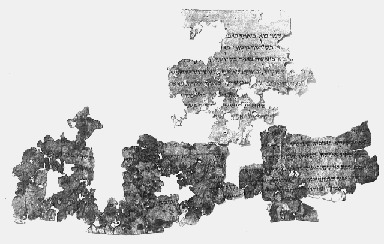A Calendrical Scroll from Qumran Cave IV
Mishmarot
4Q321 (Mishmarot B[superscript]a)
Parchment Copied ca. 50-25 B.C.E.
Height 13.4 cm (5 1/4 in.), length 21.1 cm (8 1/4 in.)
Courtesy of the Israel Antiquities Authority
A significant feature of the community was its calendar, which was based on
a solar system of 364 days, unlike the common Jewish lunar calendar, which consisted of 354 days.
The calendar played a weighty role in the schism of the community from the rest of Judaism, as
the festivals and fast days of the group were ordinary work days for the mainstream community and vice versa.
According to the calendar, the new year always began on a Wednesday, the day on which God created the heavenly
bodies. The year consisted of fifty-two weeks, divided into four seasons of thirteen weeks each, and the festivals consistently fell on the same days of the week. It appears that these rosters were intended to provide the members of the "New
Covenant" with a time-table for abstaining from important
activities on the days before the dark phases of the moon's waning and eclipse (duqah).
THE CALENDRICAL DOCUMENT SCROLL
A TRANSLATION
1. [on the first {day} in {the week of} Jedaiah {which falls} on the tw]elfth in it {the seventh month}. On the
second {day} in {the week of} Abiah {which falls} on the twenty- f[ifth in the eighth {month}; and duqah {is} on
the third] {day} 2. [in {the week of} Miyamin {which falls} on the twelfth] in it {the eighth month}. On the third
{day} in {the week of} Jaqim {which falls} on the twen[ty-fourth in the ninth {month}; and duqah {is} on the fourth]
{day} 3. [in {the week of} Shekania {which falls} on the eleven]th in it {the ninth month}. On the fifth {day}
in {the week of} Immer {which falls} on the twe[n]ty-third in the te[nth {month}; and duqah {is} on the sixth {day}
in {the week of} Je]shbeab {which falls} 4. [on the tenth in] it {the tenth month}. On the [si]xth {day} in {the
week of} Jehezkel {which falls} on the twenty-second in the eleventh month [and duqah {is on the} Sabbath in] {the
week of} Petahah {which falls} 5. [on the ninth in it {the eleventh month}]. On the first {day} in {the week of}
Joiarib {which falls} on the t[w]enty-second in the twelfth month; and [duqah {is} on the seco]nd {day} in {the
week of} Delaiah {which falls} 6. [on the ninth in it {the twelfth month}. vacat The] se[cond] {year}: The first
{month}. On the sec[on]d {day} in {the week of} Malakiah {which falls} on the tw[entieth in it {the first month};
and] duqah {is} 7. [on the third {day} in {the week of} Harim {which falls} on the seventh] in it {the first month}.
On the fou[r]th {day} in {the week of} Jeshua {which falls} [on] the twentieth in the second {month}; and [duqah
{is} on the fifth {day} in {the week of]} Haqqos {which falls} on the seventh 8. [in it {the second month}. On
the fifth {day} in {the week of} Huppah {which falls} on the nine]teenth in the third {month}; and duqa[h] {is}
on the six[th {day} in {the week of} Happisses {which falls}
Translation and transcription by S. Talmon and I. Knohl
References:
Jaubert, A. "Le Calendrier de Jubiles et de la Secte de Qumran: Ses origines Bibliques," Vetus Testamentum
3 (1953):250-64.
Talmon, S. "The Calendar of the Judean Covenanteers." In The World of Qumran from Within: Collected Studies,
pp. 147-85. Jerusalem, 1989.
Talmon, S. and I. Knohl. "A Calendrical Scroll from Qumran Cave IV -- Miþ Ba (4Q321)" (in Hebrew),
Tarbiz 60 (1991):505-21.

Mayim's Endnote